Places of Worship in Hadfield
Hadfield Wesleyan Chapel, Chapel Lane, Hadfield
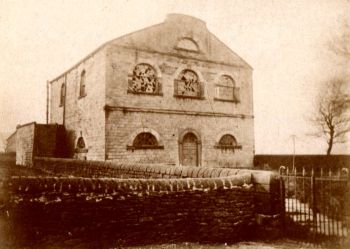
This was the original Methodist Chapel (later replaced by a new one at Bank Street, Hadfield) and was built in 1804 by Mr. John Thornley who was the owner of Valehouse Cotton Mill at a cost of £200. The original meeting room had been in his mill which is now under water at Valehouse Reservoir.
Echoes in Glossop Dale tells us: One day, in the usual course, Mr. John Thomley went to the Manchester market to transact his business. While there, a violent thunderstorm passed over the town. The storm was most terrific : the forked lightning flashed, and peal after peal of loud thunder rolled, as though man’s final reckoning day was approaching. Mr. Thornley was greatly terrified. He prayed that his life might be spared, and vowed that if it was he would build a Methodist chapel at Hadfield. His life was spared, and his vow was willingly fulfilled. On Mr. Thornley arriving at home and making known his intention to build a chapel, the intelligence was received by the Hadfield Methodists with great joy. A site was selected, and the work was at once commenced. On being completed the chapel was properly settled on trustees and presented to Conference, being enrolled according to the model deed.
The Chapel was enlarged in 1826 costing £260 and again in 1845 costing £140. New lamps costing £2. 9s. 8d were introduced in 1829 to replace candles. This was the first Methodist Chapel to be built in the Borough of Glossop and surrounding districts. A harmonium costing £26 was given in 1853 and in 1867 a small pipe organ costing £40 was installed. The existing Chapel was proving too small for the expanding congregation, for at this time cotton mills were being built along the valley and people from other parts were coming to live in the district. In 1876 the insufficient accommodation and dilapidation convinced the Trustees to build a new church - Bank St.
After the new housing estate was built around it, the graveyard was gifted to Glossop Borough Council to be maintained as an open space.
Primitive Methodist Chapel & School, Woolley Bridge Road, Hadfield.
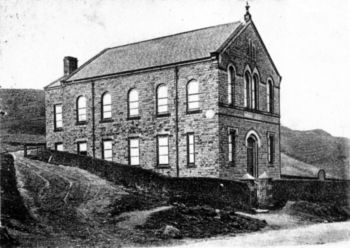
This Chapel, with School below was built in 1845 at the top of Woolley Bridge Road during the ministry of the Rev. Samuel Maddox and had seating capacity for 360
people. The original trustees were:- James Wharmby, confectioner; John Beeley, dresser; John Wilson, overlooker; Elijah Stott, dresser; James Haigh, weaver; William Chadwick, watchman; John Allcock, weaver; George Battye, grinder; John Wharmby, spinner.
In February 1922 a war memorial was unveiled by Rev. W. C. Hunter, a former minister of the Chapel.
St. Charles Borromeo R.C. Church, Hadfield.

Extracts from The story of the church of St. Charles Borromeo, Hadfield by The Very Reverend John Sullivan, M. A. (1985):
The Church was built by Lord Edward Fitzalan Howard, the first Baron Howard of Glossop, and his wife Lady Augusta, the first Baroness and opened on 18th February 1858. Before the church was built Mass was said in a house in Hollingworth.
The architects were Weightman, Hadfield & Goldie. The practice was begun in 1834 by John Gray Weightman (1801-1872) and Matthew Ellison Hadfield (1812-1885). Matthew was the eldest son of Joseph Hadfield of Lees Hall, Glossop. In 1827 at the age of 15 years he entered the offices of his uncle, Michael Ellison, then agent for the Duke of Norfolk Estates in Sheffield. The earliest building known to have been designed by Weightman and Hadfield is the Catholic Church of All Saints, Glossop.
Before any Catholic churches were built in the area, Catholics worshipped at Glossop Hall.
Between 1884 - 85 Lord Francis, 2nd Baron Howard of Glossop demolished the Lady Chapel on the north side of the sanctuary in order to construct a family vault which was completed about 1888. In it her re-interred the remains of his parents, Lord Edward Howard (d.1883), Lady Augusta (d. 1862) and his younger brother Charles (d. 1861) that were buried originally beneath the north aisle. During the ensuing years the following were also interred in the vault: Lord Francis (d.1924), his wife Lady Clara Louisa (d. 1887), their nephew Edward Wilfred Middleton (d.1890), Lord Bernard Edward, Third Baron Howard of Glossop (d.1972), and his wife Mona, Baroness Beaumont (d.1971).
The church has its own war memorial.
St Andrews Mission, Lees Street, Woolley Bridge, Hadfield
The Woolley Bridge Mission had been in existence for over 100 years when it closed in October 1964. St. Andrews Mission is just visible in centre of row of houses. Mr. Robert Lees, the owner of a local mill at Woolley Bridge and also a row of cottages in Lees Street allowed the use of an upstairs room for the Mission. Later the downstairs room was acquired and eventually the cottages were altered to make the final premises. When Hadfield became a separate parish in 1872 the Mission became associated with St. Andrews Church. The area has since been redeveloped for industrial and retail use.
St Andrews, Church Street, Hadfield.
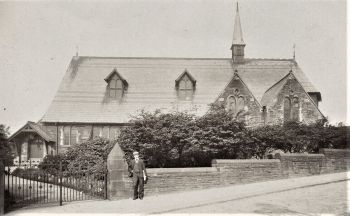
Extracts from Centenary Handbook written by Mr. D. Winterbottom:
The 1,600 square yards of land given to the working men of Hadfield by Henry Granville Fitzalan Howard, 14th Duke of Norfolk and owner of the Manor of Glossop, was in a sloping and irregular field at the back of the Railway Tavern, a field whose later development would be called Railway Street and Salisbury Street. For the village of Hadfield was now extending towards the recently built (1845) railway station. An extract from the Manchester Guardian 23rd August 1854 reads “A bazaar in aid of the fund of erecting a school house in the hamlet of Hadfield in the parish of St. James, Whitfield was held in the Town Hall, Glossop on Thursday and Friday last.... there is at present no building in Hadfield available for Divine Worship according to the ritual of the Church of England and it is intended to use the school house for that purpose until funds warrant the commencement of a Church”. A further extract dated 11th November 1854 reads “a church school is shortly to be erected at Hadfield. The Duke of Norfolk has given land for the site”.
In 1855 the School was completed and brought into use. Services were performed there twice every Sunday by the officiating curate, Rev. T. M. Freeman. The Sunday School activities were complemented by its use also as a Day School for children whose parents would pay two or three pence a week.
In February 1872 a site “near the present school” was selected and granted by Lord Howard of Glossop at a cost of £557 and a firm of architects, M. & M. Taylor of Manchester were engaged to design a building with a ground plan like that of Glossop Church but “with different external appearance, a much smaller spire and no gallery”. It is a building in the Gothic style. The contract for the foundation work was given to Mr. T. Holroyd and the ceremonial laying of the foundation stone was fixed for 30th November 1872.
An elaborate procession through the village was organised for the stone laying ceremony, it was led by Waterside Band. Those who prominently featured in the procession were members of the Orange Lodge, members of the Borough Council including Councillor Eastham of The Thorns, Hadfield who was on horseback, Mr. & Mrs. Samuel Wood, Colonel Sidebottom and his sister Lucy Hannah. The stone was laid by the Vicar of Glossop, Rev. J. D. Knowles.
The Church was built by Mr. T. Wharam and was consecrated by the Bishop of Lichfield, Dr. Selwyn on Saturday 4th July 1874 when it was “scarcely yet finished”. The first Vicar was Rev. Joseph Hadfield - he had his Church, bare of decoration at first but an enthusiastic congregation. He moved into his vicarage “having been purchased and conveyed by the Ecclesiastical Commissioners” in a house adjacent to the Old Cross. His incumbency was to last 43 years. His successor was Rev. A. C. M. White who died whilst chatting to workmen inside the Church in 1956.
The font, worked in native stone, was presented by Mr. James Sherriff, of Canterbury, New Zealand who was previously a native of Hadfield was sent “carriage paid” from New Zealand to Hadfield Railway Station.
The Church is still in use today.
The church has its own war memorial.
Hadfield Free Methodist, Station Road, Hadfield.
A group of local people decided to open a Free Methodist Chapel in Hadfield in 1875. The original intention was to build in Kiln Lane but the land was not available so a site on Station Road was chosen. The foundation stone was laid by Mr. T. Platt of Hadfield in October 1876. The original builder was Wright Gill of Hadfield but financial difficulty meant that the work was finished by Cyrus Garside of Glossop. The opening service was held
in May 1877. At first there were only 12 pews but it wasn't long before extensions almost doubled the size. Congregations declined as a result of mass unemployment and the second world war and Hadfield Free Methodist Chapel was closed for good in 1942.
The building is still in use today as Carmel Pentecostal Chapel.
Bank Street Methodist Chapel, Hadfield
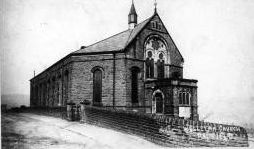
Ten foundation stones for the new Sunday School and Chapel at the top of Bank Street were laid on 7th July 1877. The new chapel, with seating for 600 persons was opened on October 16th 1878. A baptismal font was given in memory of Private John Burgess who was killed on 2nd December 1917. Inside the Chapel were memorial tablets to Alfred Shaw - a class leader at the Sunday School who died in May 1928, and Andrew N. Ninnes, also a class leader, Sunday School Superintendent and Preacher who died in March 1942 after 60 years of service to the Chapel and Circuit. There was a beautifully carved oak table and chair in memory of Joseph John Ninnes.
The Bank Street chapel building was destroyed by fire in 1997 and has since been demolished.
The chapel had its own war memorial.
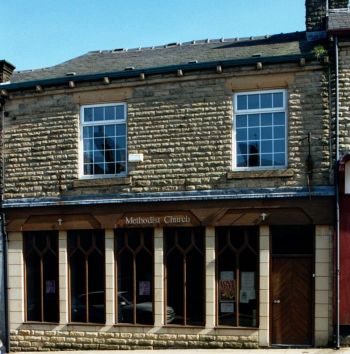
The congregation moved to a former shop in Station Road, Hadfield on 4th May 1996.
Brookfield Independent (later Congregational) Chapel, Brookfield.
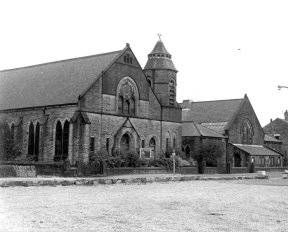
The foundation stone for the new Church was laid by William Shepley (the then owner of Brookfield mill) in November 1883. There was a procession led by Mottram Brass Band and in a cavity under the stone several items of interest were placed. When the tower was demolished nearly 90 years later the stone was lifted and the bottle discovered but unfortunately it had been damaged by water seeping in the cavity.
In 1956 Brookfield joined with Littlemoor Church, Glossop to share a group Pastorate which continued for eight years.
At an annual church meeting on 24th May 1967 it was decided to sell the Church building and convert part of the adjacent schoolroom into a Chapel.
The Church building was sold in 1971. This Chapel was opened and dedicated in March 1972, the service was conducted by the Rev. F. Barker. The service was attended by a large congregation including the Mayor and Mayoress of Glossop. Soon after opening it was to become part of the grater United Reform Church formed by the union of the Congregational and Presbyterian churches.
The Brookfield Chapel (by now United Reform) was closed in June 1981 due to a largely decreasing congregation.
The chapel is now used as a retail DIY premises
The chapel had its own war memorial, moved to Tintwistle after the chapel was demolished.
Carmel Pentecostal, Station Road, Hadfield.

The Pentecostal Chapel was established in Hadfield in 1969 under the guidance of Pastor F. E. Durrant. The chapel took over the building first used by the Hadfield Free Methodist Chapel, built in 1875.
Holy Spiritual Church, Hadfield.
The church, part of the Spiritualists National Union, is on Jones Street.
Return to GJH.me Home Page, Return to Glossop Area Local Histories index.
Last updated: 12 December 2021







